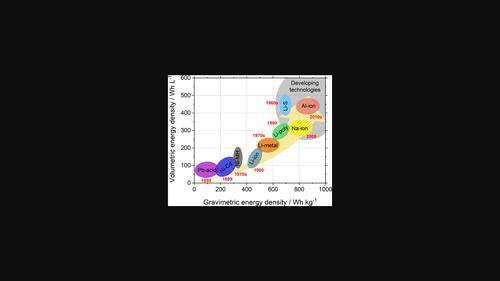可充电电池技术的最新进展
IF 5.4
3区 工程技术
Q2 ENERGY & FUELS
引用次数: 4
摘要
近年来,全球范围内持续存在的能源问题导致电化学储能系统不断发展,电池是其中的重要组成部分。电池市场(主要是可充电电池)正在迅速扩张,以满足不断变化的社会的需求,同时电池在电动汽车、可再生能源部门、,以及工业部门。从铅酸电池等成熟技术到最先进的锂离子电池,可充电电池技术得到了显著发展。与传统的铅酸电池相比,其他可充电电池技术,如锂离子、镍金属氢化物(NiMH)和镍镉(Ni–Cd)电池,被认为是更有前途的电化学储能系统。锂离子电池自1991年开始上市,由于其高能量密度和良好的耐用性,是最受欢迎的可充电电池。随着市场对在比能、可循环性、稳定性和更好的安全性方面具有优异电化学性能的电池的需求不断增长,下一代锂离子电池近年来正在被广泛探索。这篇综述讨论了各种正在发展的可充电电池及其相关的问题和挑战。讨论了自2000年以来,主要在电极(阴极和阳极)材料以及电解质方面取得的进步,以提高电池性能。此外,本综述还涵盖了对下一代电池的讨论。本文章由计算机程序翻译,如有差异,请以英文原文为准。

Recent advancement in rechargeable battery technologies
The ongoing energy issues worldwide have led to the continuous growth of the electrochemical energy storage system in recent years, and the battery is a vital part of it. The battery market, mainly rechargeable batteries, is expanding rapidly to cater to the demands of the changing society, along with the utilization of batteries in electric vehicles, the renewable energy sector, and the industrial sector. From the matured technology like the lead–acid battery to the most advanced Li‐ion (Li‐ion) battery, rechargeable battery technology has developed significantly. In comparison to the conventional lead–acid battery, other rechargeable battery technologies such as Li‐ion, nickel–metal hydride (NiMH), and nickel–cadmium (Ni–Cd) batteries are considered as more promising electrochemical energy storage systems. The Li‐ion battery, which has been on the market since 1991, is the most popular rechargeable battery due to its high energy density and good durability. With the growing market demand of battery with superior electrochemical performance in terms of specific energy, cyclability, stability, and better safety, next generation Li‐ion batteries are being widely explored in the recent time. This review discusses various rechargeable batteries which are in trend and the issues and challenges associated with it. The advancements that have taken place primarily in the electrode (both cathode and anode) materials, along with electrolytes, for improving the battery performance from the year 2000 onwards are discussed. Moreover, discussion on next‐generation batteries is also covered in this review.
求助全文
通过发布文献求助,成功后即可免费获取论文全文。
去求助
来源期刊

Wiley Interdisciplinary Reviews-Energy and Environment
ENERGY & FUELS-
CiteScore
11.70
自引率
3.30%
发文量
42
期刊介绍:
Wiley Interdisciplinary Reviews: Energy and Environmentis a new type of review journal covering all aspects of energy technology, security and environmental impact.
Energy is one of the most critical resources for the welfare and prosperity of society. It also causes adverse environmental and societal effects, notably climate change which is the severest global problem in the modern age. Finding satisfactory solutions to the challenges ahead will need a linking of energy technology innovations, security, energy poverty, and environmental and climate impacts. The broad scope of energy issues demands collaboration between different disciplines of science and technology, and strong interaction between engineering, physical and life scientists, economists, sociologists and policy-makers.
 求助内容:
求助内容: 应助结果提醒方式:
应助结果提醒方式:


